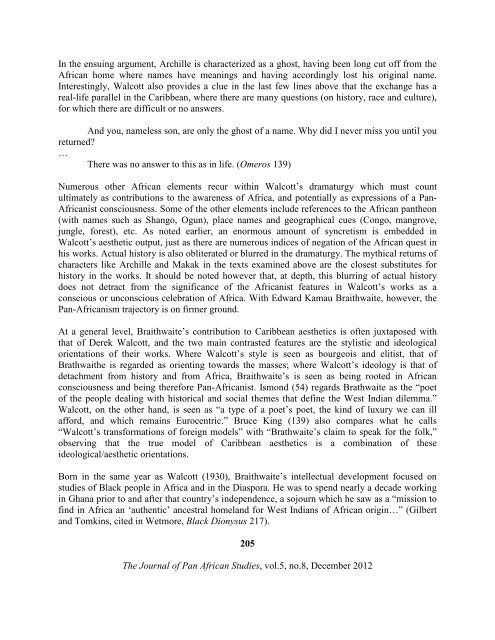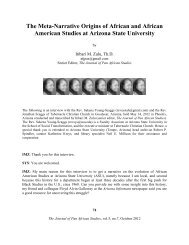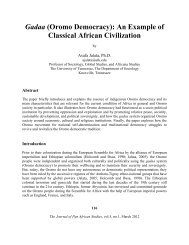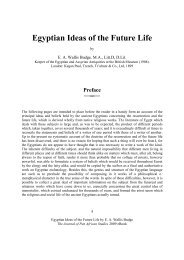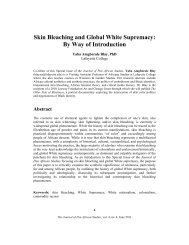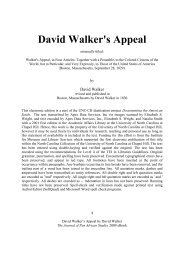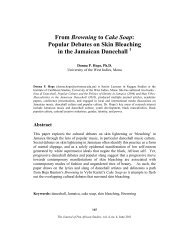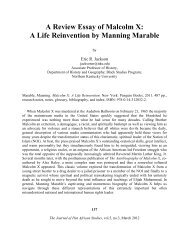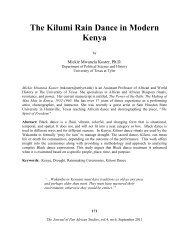view PDF - Journal of Pan African Studies
view PDF - Journal of Pan African Studies
view PDF - Journal of Pan African Studies
You also want an ePaper? Increase the reach of your titles
YUMPU automatically turns print PDFs into web optimized ePapers that Google loves.
In the ensuing argument, Archille is characterized as a ghost, having been long cut <strong>of</strong>f from the<br />
<strong>African</strong> home where names have meanings and having accordingly lost his original name.<br />
Interestingly, Walcott also provides a clue in the last few lines above that the exchange has a<br />
real-life parallel in the Caribbean, where there are many questions (on history, race and culture),<br />
for which there are difficult or no answers.<br />
And you, nameless son, are only the ghost <strong>of</strong> a name. Why did I never miss you until you<br />
returned?<br />
…<br />
There was no answer to this as in life. (Omeros 139)<br />
Numerous other <strong>African</strong> elements recur within Walcott’s dramaturgy which must count<br />
ultimately as contributions to the awareness <strong>of</strong> Africa, and potentially as expressions <strong>of</strong> a <strong>Pan</strong>-<br />
<strong>African</strong>ist consciousness. Some <strong>of</strong> the other elements include references to the <strong>African</strong> pantheon<br />
(with names such as Shango, Ogun), place names and geographical cues (Congo, mangrove,<br />
jungle, forest), etc. As noted earlier, an enormous amount <strong>of</strong> syncretism is embedded in<br />
Walcott’s aesthetic output, just as there are numerous indices <strong>of</strong> negation <strong>of</strong> the <strong>African</strong> quest in<br />
his works. Actual history is also obliterated or blurred in the dramaturgy. The mythical returns <strong>of</strong><br />
characters like Archille and Makak in the texts examined above are the closest substitutes for<br />
history in the works. It should be noted however that, at depth, this blurring <strong>of</strong> actual history<br />
does not detract from the significance <strong>of</strong> the <strong>African</strong>ist features in Walcott’s works as a<br />
conscious or unconscious celebration <strong>of</strong> Africa. With Edward Kamau Braithwaite, however, the<br />
<strong>Pan</strong>-<strong>African</strong>ism trajectory is on firmer ground.<br />
At a general level, Braithwaite’s contribution to Caribbean aesthetics is <strong>of</strong>ten juxtaposed with<br />
that <strong>of</strong> Derek Walcott, and the two main contrasted features are the stylistic and ideological<br />
orientations <strong>of</strong> their works. Where Walcott’s style is seen as bourgeois and elitist, that <strong>of</strong><br />
Brathwaithe is regarded as orienting towards the masses; where Walcott’s ideology is that <strong>of</strong><br />
detachment from history and from Africa, Braithwaite’s is seen as being rooted in <strong>African</strong><br />
consciousness and being therefore <strong>Pan</strong>-<strong>African</strong>ist. Ismond (54) regards Brathwaite as the “poet<br />
<strong>of</strong> the people dealing with historical and social themes that define the West Indian dilemma.”<br />
Walcott, on the other hand, is seen as “a type <strong>of</strong> a poet’s poet, the kind <strong>of</strong> luxury we can ill<br />
afford, and which remains Eurocentric.” Bruce King (139) also compares what he calls<br />
“Walcott’s transformations <strong>of</strong> foreign models” with “Brathwaite’s claim to speak for the folk,”<br />
observing that the true model <strong>of</strong> Caribbean aesthetics is a combination <strong>of</strong> these<br />
ideological/aesthetic orientations.<br />
Born in the same year as Walcott (1930), Braithwaite’s intellectual development focused on<br />
studies <strong>of</strong> Black people in Africa and in the Diaspora. He was to spend nearly a decade working<br />
in Ghana prior to and after that country’s independence, a sojourn which he saw as a “mission to<br />
find in Africa an ‘authentic’ ancestral homeland for West Indians <strong>of</strong> <strong>African</strong> origin…” (Gilbert<br />
and Tomkins, cited in Wetmore, Black Dionysus 217).<br />
205<br />
The <strong>Journal</strong> <strong>of</strong> <strong>Pan</strong> <strong>African</strong> <strong>Studies</strong>, vol.5, no.8, December 2012


